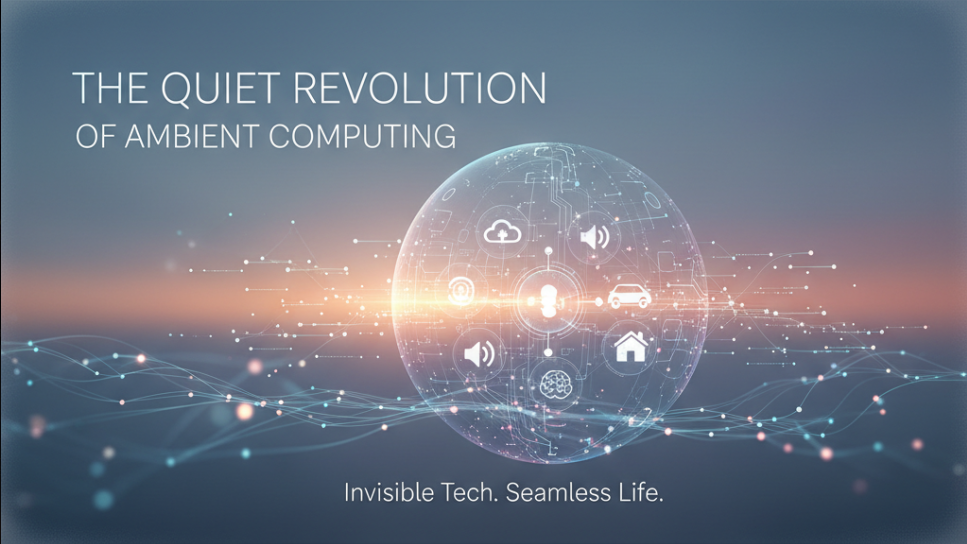We have become masters of the screen. Our thumbs dance across glass, summoning information and connecting with others in an instant. This active, demanding relationship with technology has defined the last two decades. We tap, we swipe, we command. But a fundamental shift is already underway, one that doesn’t add a new screen to our lives but rather subtracts the need for them. This is the dawn of ambient computing, a paradigm where technology quietly recedes into the background, becoming as invisible and natural as the air we breathe. It is the gentle evolution from smart devices to truly intelligent environments.
The core promise is deceptively simple. Imagine a world where your environment anticipates your needs without explicit instruction. You walk into a room and the lighting adjusts to your preferred level for reading. Your morning coffee begins brewing the moment your alarm, sensing you are truly awake, is disabled. This isn’t about a single clever gadget. It is the orchestration of countless connected sensors and systems working in perfect harmony. The technology is no longer a destination you go to; it is the fabric of the space you inhabit, constantly learning and adapting.
From Active Commands to Passive Experience
The journey towards this future began with the Internet of Things, or IoT. We started by connecting individual items like thermostats, speakers, and light bulbs to the internet. While useful, this first wave often created more complexity, forcing us to manage dozens of separate apps. It was a collection of solo musicians, not a symphony. Ambient computing is the conductor, enabling these devices to not only talk to the internet but, more importantly, to talk to each other. This interconnectedness creates a responsive ecosystem that operates on context rather than direct commands.
Your car, for instance, could know from your calendar that you have a stressful meeting first thing in the morning. It might suggest a more scenic route and automatically play a calming playlist. Your office environment could adjust the temperature and air quality based on the number of people in a meeting room, optimizing for comfort and focus. The focus moves from user interface to user experience. The best interface, in the ambient world, is no interface at all. Technology simply serves the human need and then disappears from conscious thought.
The Pillars of an Unseen World
This seamless integration doesn’t happen by magic. It rests on a convergence of powerful technologies. First is the proliferation of low-cost, high-efficiency sensors embedded in everything from furniture to clothing. Second is the backbone of persistent connectivity, powered by 5G and the upcoming 6G networks, ensuring data flows instantly and reliably. The final piece is the decentralized intelligence that processes this vast amount of data. This involves edge computing, where decisions are made locally on a device for speed, and cloud systems for more complex analysis and learning over time.
This isn’t just about convenience. The applications in healthcare are profound. Wearable sensors can monitor vital signs and detect anomalies in real-time, alerting medical professionals to a potential crisis before it happens. For the elderly or those with disabilities, an ambient home can provide a powerful sense of independence and safety, detecting falls or changes in routine that may signal a problem. It transforms environments from passive structures into active participants in our well-being.
Navigating the Challenges of Trust and Privacy
Of course, a world that is always listening and sensing brings monumental challenges. The most significant hurdles are not technical but ethical. Who owns the data generated by your life’s rhythms? How is it protected? The potential for misuse, whether by corporations for invasive marketing or by malicious actors for surveillance, is enormous. Building this future responsibly requires a new social contract around data. Transparency and user control must be the bedrock of any ambient system.
We must have clear, simple controls over what data is collected and how it is used. The concept of “privacy by design” becomes paramount, meaning that systems are built from the ground up to protect user information, not as an afterthought. Without establishing this deep foundation of trust, the dream of ambient computing could easily become a nightmare of digital intrusion. The success of this revolution will be measured not by its technical prowess, but by its ability to earn and maintain our confidence.
The era of the glowing rectangle will not end overnight. But we are undeniably moving toward a more integrated, human-centric relationship with technology. The goal is not to fill our world with more gadgets, but to imbue our environments with a quiet, helpful intelligence. It’s a future where technology doesn’t demand our attention, but instead gives us more of it back to focus on what truly matters. The quiet revolution has begun, and it promises to change everything, precisely by feeling like nothing has changed at all.
The Future is Felt, Not Seen
The era of the glowing rectangle will not end overnight, but we are undeniably moving toward a more integrated, human-centric relationship with technology. The ultimate goal of ambient computing is not to fill our world with more gadgets, but to imbue our environments with a quiet, helpful intelligence that serves us without demanding anything in return. The path forward requires a conscious choice: a future built on trust, transparency, and user empowerment, or one of unchecked data collection. The quiet revolution has begun. Its success will be measured by its ability to finally let technology disappear, so we can be more present in our own lives.
The screens we carry are merely a transitional phase—a bridge from the analog past to a truly digital future. The final destination of technology has never been a device in our pocket; it is an environment that understands us. The ultimate goal of ambient computing is to dismantle the barriers between our intentions and their outcomes, creating a frictionless world where our needs are met proactively.
This is more than just convenience; it is a fundamental redefinition of our interaction with the digital realm. The path forward requires a conscious choice: a future built on trust and empowerment, or one of unchecked data collection. The quiet revolution has begun, and it will not be televised on a screen. It will be felt in the air, seen in the seamless flow of our daily lives, and realized when we finally forget the technology is even there. The measure of its success will be simple: when we stop commanding our world and begin to simply live within it.
Ambient Computing, IoT, Smart Home, User Experience, UX, Future of Tech, Invisible UI, Connectivity, Data Privacy, 5GAmbient Computing, IoT, Smart Home, User Experience, UX, Future of Tech, Invisible UI, Connectivity, Data Privacy, 5G

A storyteller navigating the globe. On this page, I bring you the events shaping our world through my own lens. My mission is to enlighten with information.











